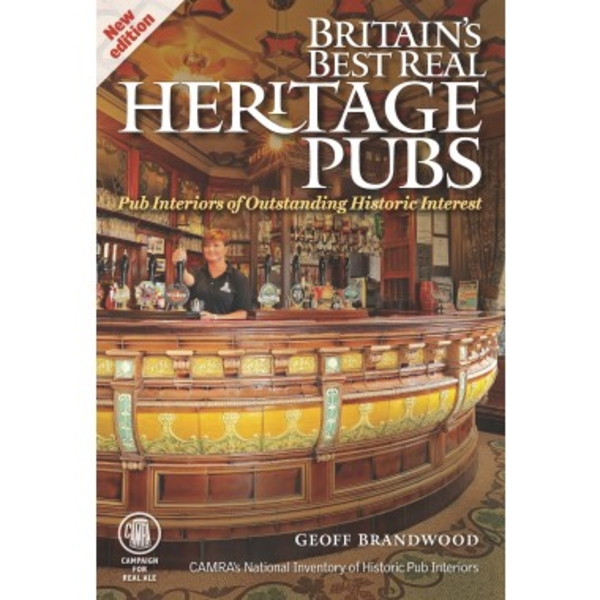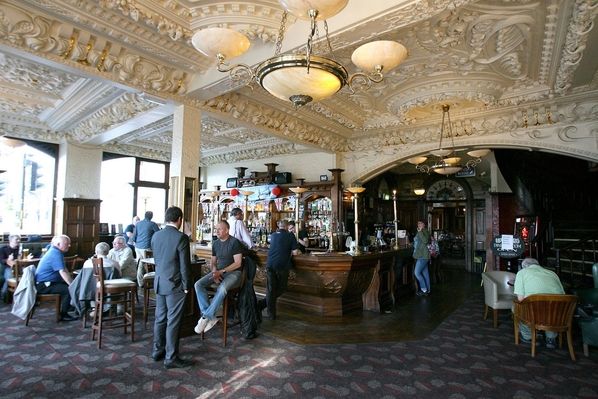Big boost for Britain's pub glory
Added: Saturday, August 27th 2016

Britain’s Best Real Heritage Pubs, Geoff Brandwood (CAMRA Books, £9.99)
Along with MBEs, CBEs and sundry other gongs, there should be an annual award of HOTBP – Hero of the British Pub. Geoff Brandwood would be the first recipient in recognition of his dedication to boosting Britain’s pub heritage.
To those who think CAMRA is only about beer, think again. Since the 1980s, its Pub Heritage Group has been touring the country compiling a database of pubs with interiors of historic and architectural importance. Thanks to the work of the PHG, often obscure pubs in isolated areas have been brought to public attention. Some have been given recognition as listed buildings, others have been saved from closure and demolition.
What emerges from the pages of this beautifully designed book – remarkable value for a full-colour volume packed with stunning photographs – is both a panoramic portrait of the pub and also its richness and diversity. With the exception of Ireland, no other country has such a vast collection of drinking places that span the centuries.
Geoff Brandwood is CAMRA at its best – someone who dedicates large swathes of his life to traversing the country to log, describe and photograph hostelries ancient and modern. Within these pages you will find examples of tuppence coloured and penny plain pubs. Some are rudimentary old ale houses built to refresh farm labourers. Others are grand and opulent, full of Victorian and Edwardian pomp and grandeur, reflecting our imperial pride.
There are pleasurable surprises, such as the elegant Eastbrook in Dagenham, best-known for the Ford car factory, decked out in harmonious walnut. A few miles away, along the Barking Road, you will find the Boleyn Tavern next to the old West Ham United ground and wonder if this stupendous four-storey extravaganza of tiles, timber and etched glass will survive now the football club has decamped to Stratford.
If only brewers still owned pubs rather than wretched “pubcos”! So much of the wonder and beauty of our pubs, those in city centres in particular, are due to cash-rich brewers calling on the skills of designers and architects to create symphonies of brick, wood and glass. Their efforts enabled people of all backgrounds to enjoy a beer or two in comfortable and harmonious places when community was as important as profit.

The book is a sumptuous feast of pubs in all their glory in central London, Birmingham, Liverpool, Edinburgh and Glasgow. Geoff talks of the “Marvels of Merseyside” as he describes in loving detail the lush delights of the Crown, the Philharmonic and the Vines. The Crown, built by Walkers of Warrington around 1905, offers the finest welcome to any city, standing and beckoning across the road from Lime Street station. It’s good to hear that, when not in use, ladies may inspect the glorious “gents” in the Philharmonic and then restore their equilibrium with a fresh glass in the Art Nouveau delights of the ground-floor rooms.
Simpler pubs are not ignored. The earliest images in the book show the Cock at Broom in Bedfordshire, the New Beehive in Bradford and the “unassuming” Vine in Tunstall, Staffs, all lacking any pretension but, with their basic brick and tiled interiors, showing how people’s homes expanded into back-street ale houses for working people.
The role of the pub matriarch is not overlooked. Geoff includes the likes of Nellie’s in Beverley, Ma Pardoe’s in the Black Country and Doris’s on the Romney Marsh, where the fame and firm hand of the ladies in question meant their names took over from the more prosaic ones on the inn signs.
There are some fascinating sidebars in the book. One section debunks such myths as Nottingham’s Trip to Jerusalem being England’s oldest pub while Frank Crocker, who built Crocker’s Folly in London’s St John’s Wood, didn’t commit suet pudding when Marylebone Station opened a mile from its expected location.
Geoff proves that the camera can lie. Who would have thought that Edinburgh’s Oxford Bar, haunt of Ian Rankin and Inspector Rebus, was replaced by a Glasgow pub on TV as the Ox was considered too small. And the Crown Tavern in Belfast, which appeared in Carol Reed’s 1947 thriller Odd Man Out (with William Hartnell, the first Dr Who, behind the bar) was actually a recreation on the film set. So much for post-war austerity!
While there is no shortage of pubs named after kings, queens, nobs and nabobs, the book also reminds us, with the likes of the Painters, the Blacksmiths, the Malt Shovel, the Square & Compass and the Plough, that ale houses were once built to refresh people
engaged in manual labour. Will the heritage group one day list the Old Hedge Fund Manager – I somehow doubt it, though I pass on the suggestion to JD Wetherspoon free of charge.
The book ends on a sad note with a section devoted to some heritage pubs that, despite the best efforts of Geoff and his colleagues, have gone under the hammer. It’s proof, if proof were needed, that all of us who love and adore the British pub must never relax in our efforts to save them and keep them in the important business of delivering good beer and good cheer.








